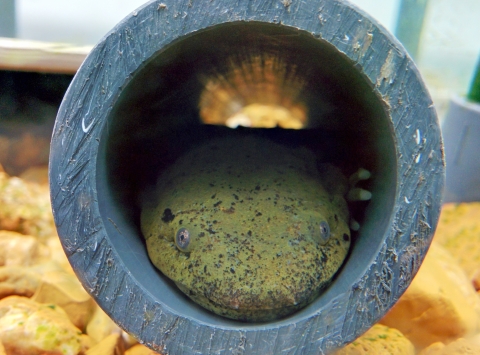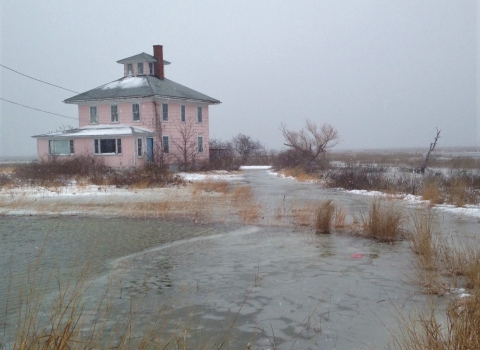Paddlers enjoying a canoe trip down a Missouri stream may float right over one of the continent’s largest and most imperiled salamanders. The Ozark hellbender, a federally endangered species, is a fascinating, little-known amphibian struggling to survive in a changing world. We at the U.S. Fish and Wildlife Service are working with partners to make sure the Ozark hellbender, and its close relative the eastern hellbender, remain part of our natural landscape.
These fantastic beasts are actually gentle giants. Hellbenders are large, fully aquatic salamanders, meaning they spend all of their lives in water. Growing to lengths of more than 2 feet, they are the continent’s largest salamander. They are brown and blotchy, broad and flat, with four stumpy legs, tiny eyes and a long tail. Folds of skin along their sides sometimes give them a ruffled appearance, although they serve as an aid to respiration.
While the eastern hellbender lives in streams and rivers in 15 states from New York to Mississippi, you’ll find the Ozark subspecies only in southern Missouri and northern Arkansas. These two subspecies share a preference for cool, clear streams and rivers with many large rocks. Cool, clean water is important because adult hellbenders breathe entirely through their skin (young hellbenders lose their gills at about 2 years old).
This reliance on clean water is one reason why hellbender populations may have declined over the past few decades. The Ozark hellbender was commonly found through the 1970s, but began to decline, possibly due in part to degraded water quality in the streams and rivers it inhabited. Dam construction, sand and gravel mining and other activities increased sediments in the water and otherwise altered water quality and flow. Other causes for decline include disease (particularly amphibian chytrid fungus), illegal collection, disturbance of nesting and resting areas on river bottoms and pollution. The Ozark subspecies became a federally endangered species in 2011; about 915 Ozark hellbenders continue to live in southern Missouri and northern Arkansas.
The same threats affect the eastern hellbender. Although it is still common in most of its historical range, populations are declining; small, separate populations of eastern hellbenders in Missouri are listed as federally endangered under the Endangered Species Act.
Fortunately for the hellbender, there is a strong partnership of agencies and organizations working to ensure the survival these fantastic beasts. Working together with us are the Missouri Department of Conservation, Arkansas Game and Fish Commission, Saint Louis Zoo, the National Park Service and the U.S. Forest Service. A plan is under development to guide recovery efforts for the Ozark hellbender to help slow or reverse its decline. Partners are using nest boxes to create nesting habitat, monitoring populations, researching reasons for the population declines and refining techniques to collect eggs and raise and release young hellbenders. The Saint Louis Zoo now breeds Ozark hellbenders in captivity to produce young that will later be released into the wild.
Monitoring for hellbenders is important but challenging. Their preference for hiding under large rocks makes them difficult to find, but partners have found a way to detect their presence using DNA testing in water samples. Biologists are now testing a number of rivers and streams where hellbenders have been absent to see if they can locate additional populations.
Here are a few things you can do to help Ozark and eastern hellbenders
- If you catch a hellbender while fishing, simply cut the line near the head and release it back into the river. The hook will rust away in a matter of weeks.
- Protect hellbenders from disturbance. They depend on large flat rocks for shelter. If you’re canoeing or kayaking, don’t move large rocks on the streambed.
- Help keep local rivers and streams clean and natural. Join a local Stream Team, a volunteer organization that brings people together to clean, care for and monitor rivers.
- If you canoe or fish, keep your rivers and lakes clean by leaving no waste behind.
- Keep pollutants out of watersheds by limiting use of pesticides and properly disposing of household toxic waste. Avoid hosing spills, dirt and debris down storm drains.
Hellbender fun facts
- Hellbenders have lungs, but they breathe through the pores of their skin.
- Male hellbenders excavate nests and guard fertilized eggs.
- Hellbenders may live up to 25 years or longer.
- Other names for hellbenders are snot otters (because of their shape and slimy skin), mud cats and devil dogs.
- They can swim, but hellbenders most often walk along stream and river beds.
- Hellbenders spend most of their time hiding out under large, flat rocks watching for prey; they feed at night, almost entirely on crayfish.
- Missouri is the only place on the continent where both the eastern and the Ozark hellbender subspecies occur





